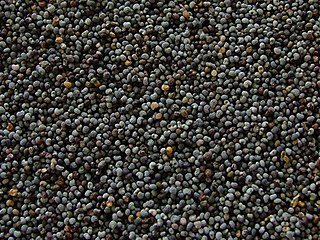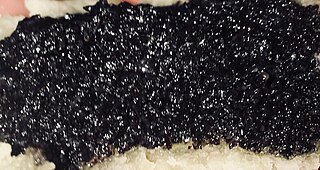
Dessert is a course that concludes a meal. The course consists of sweet foods, such as cake, biscuit, ice cream and possibly a beverage such as dessert wine and liqueur. Some cultures sweeten foods that are more commonly savory to create desserts. In some parts of the world there is no tradition of a dessert course to conclude a meal.

Dough is a thick, malleable, sometimes elastic paste made from grains or from leguminous or chestnut crops. Dough is typically made by mixing flour with a small amount of water or other liquid and sometimes includes yeast or other leavening agents, as well as ingredients such as fats or flavorings.

Marzipan is a confection consisting primarily of sugar and almond meal, sometimes augmented with almond oil or extract.

Shortbread or shortie is a traditional Scottish biscuit usually made from one part white sugar, two parts butter, and three to four parts plain wheat flour. Shortbread does not contain any leavening, such as baking powder or baking soda. Shortbread is widely associated with Christmas and Hogmanay festivities in Scotland, and some Scottish brands are exported around the world.

Dutch cuisine is formed from the cooking traditions and practices of the Netherlands. The country's cuisine is shaped by its location on the fertile Rhine–Meuse–Scheldt delta on the European Plain bordering the North Sea, giving rise to fishing, farming, and overseas trade. Due to the availability of water and flat grassland, the Dutch diet contains many dairy products such as cheese and butter, and is relatively high in carbohydrates and fat.

A bear claw is a sweet, yeast-raised pastry, a type of Danish, originating in the United States during the mid-1910s. In Denmark, a bear claw is referred to as a kam. France also has an alternate version of that pastry: patte d'ours, created in 1982 in the Alps. The name bear claw as used for a pastry is first attested in March 1914 by the Geibel German Bakery, located at 915 K Street in downtown Sacramento. The phrase is more common in Western American English, and is included in the U.S. Regional Dialect Survey Results, Question #87, "Do you use the term 'bear claw' for a kind of pastry?"

A macaron or French macaroon is a sweet meringue-based confection made with egg white, icing sugar, granulated sugar, almond meal, and often food colouring.

Almond paste is made from ground almonds or almond meal and sugar in equal quantities, with small amounts of cooking oil, beaten eggs, heavy cream or corn syrup added as a binder. It is similar to marzipan, but has a coarser texture. Almond paste is used as a filling in pastries, but it can also be found in chocolates. In commercially manufactured almond paste, ground apricot or peach kernels are sometimes added to keep the cost down.

In many European countries, particularly in Central and Eastern Europe, there are various traditions surrounding the use of bread during the Easter holidays. Traditionally the practice of eating Easter bread or sweetened "communion" bread traces its origin back to Byzantium, Eastern Catholicism and the Orthodox Christian church. The recipe for sweetened or "honey-leavened" bread may date back as far as the Homeric Greek period based on anecdotal evidence from classical texts.
Canarian cuisine refers to the typical dishes and ingredients in the cuisine of the Canary Islands, and it constitutes an important element in the culture of its inhabitants. Its main features are the freshness, variety, simplicity, and richness of its ingredients, the mix of seafood and meat dishes, its cultural influences and the low knowledge of it by the rest of the world. Canarian cuisine is influenced by other cultures, especially that of the aboriginal inhabitants of the islands (Guanches), and has influenced Latin American cuisine.

Poppy seed is an oilseed obtained from the opium poppy. The tiny, kidney-shaped seeds have been harvested from dried seed pods by various civilizations for thousands of years. It is still widely used in many countries, especially in Central Europe and South Asia, where it is legally grown and sold in shops. The seeds are used whole or ground into meal as an ingredient in many foods – especially in pastry and bread – and they are pressed to yield poppyseed oil.

Makroudh, also spelled Makrout, is a cookie from the cuisine of the Maghreb. It is filled with dates and nuts or almond paste, that has a diamond shape – the name derives from this characteristic shape.

Qurabiya, is a shortbread-type biscuit, usually made with ground almonds. Versions are found in most Arab and Ottoman cuisines, with various different forms and recipes. They are similar to polvorones from Andalusia.
Romani cuisine is the cuisine of the ethnic Romani people. There is no specific "Roma cuisine"; it varies and is culinarily influenced by the respective countries where they have often lived for centuries. Hence, it is influenced by European cuisine even though the Romani people originated from the Indian subcontinent. Their cookery incorporates Indian and South Asian influences, but is also very similar to Hungarian cuisine. The many cultures that the Roma contacted are reflected in their cooking, resulting in many different cuisines. Some of these cultures are Middle European, Germany, Great Britain, and Spain. The cuisine of Muslim Romani people is also influenced by Balkan cuisine and Turkish cuisine. Many Roma do not eat food prepared by a non-Roma.

Banket (bahn-KET) is a type of sweet pastry filled with almond paste, which originated in the Netherlands. It is made in several forms, each of which go by various names. One variety consists of long bars or loaves which are sliced into individual servings – also referred to in English as almond rolls or almond patties, and in Dutch as banketstaven. Another variety are rolled logs shaped into letters – also referred to in English as Dutch letters, banket letters, almond letters, or butter letters; and in Dutch as banketletter or boterletter. It is sometimes made as individual banket or almond patties.

Poppy seed paste, also known as mohn, is a common ingredient in Ashkenazi Jewish pastries and desserts. It is made from ground poppy seeds and additional sweeteners. Examples of pastries featuring the filling include mohn kichel, babka, and, most famously, hamantashen. In Jewish cuisine, the filling is traditionally referred to as mohn, the word for poppy in both Yiddish and German. Poppy seed-filled pastries are particularly associated with the holiday of Purim.















